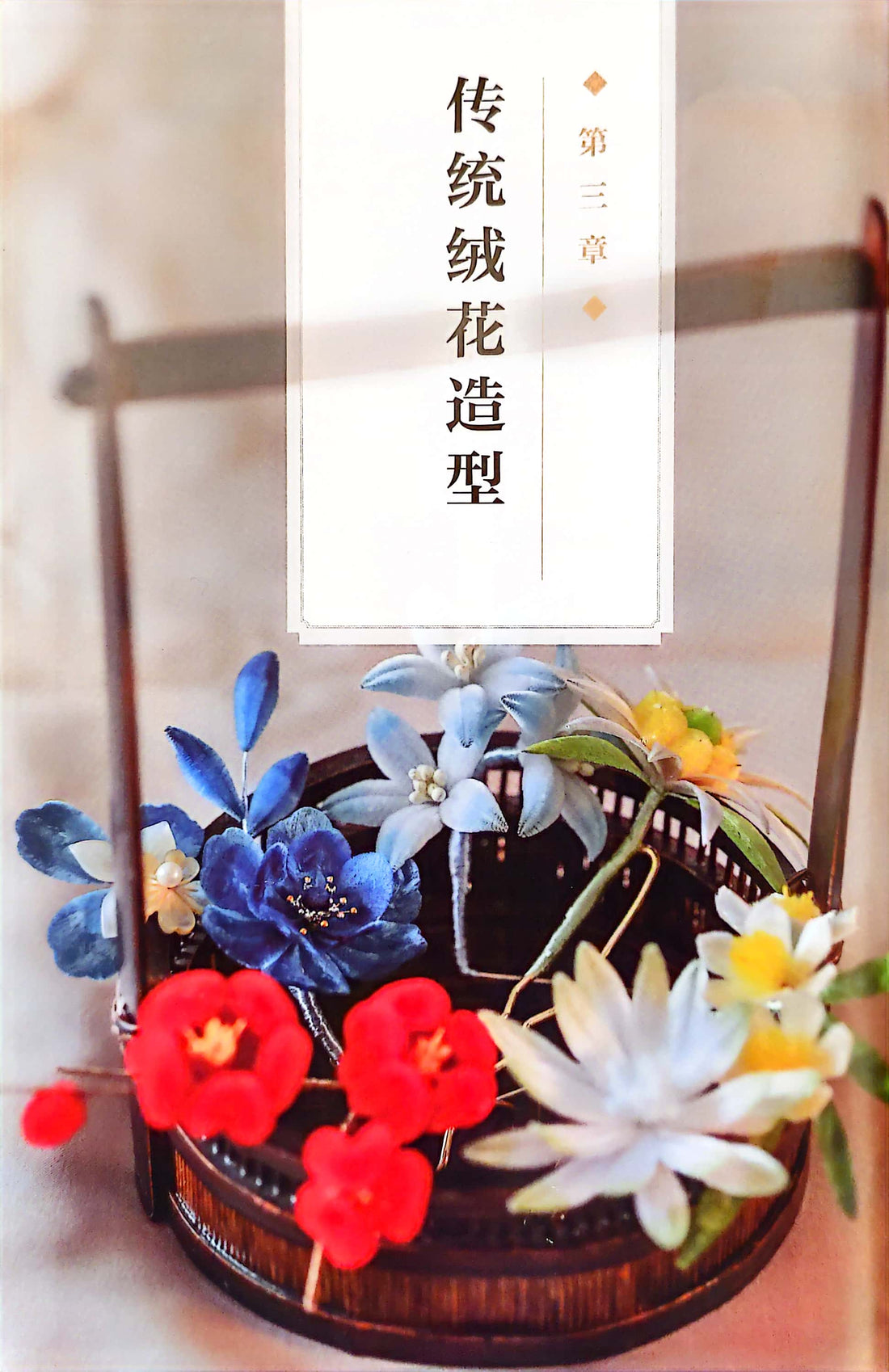
Palace-Style Ribbon Bird - Handcraft Ronghua Tutorial
Share
Materials and Tools: Velvet strips, Silk threads, Hairpin stick, Ruler, Scissors, Tweezers, White glue, Lighter
The Palace-Style Ribbon Bird, commonly referred to as the "Da Sanduo," combines the motifs of "Fushou Sanduo" (symbols of fortune, longevity, and progeny) and the Ribbon Bird, which is traditionally believed to represent the spirits of Liang Shanbo and Zhu Yingtai, symbolizing happiness and longevity. This motif gained popularity from the TV drama "Story of Yanxi Palace," where Empress Fucha wore a blue "Da Sanduo" headpiece, crafted by Nanjing intangible cultural heritage Ronghua(velvet flower) inheritor Zhao Shuxian. This creation was a secondary artistic interpretation based on the original artifact. Learning this motif allows for creative freedom in color combinations. Due to the complexity of this design, the production process is divided into six parts for ease of learning.
Part 1: Leaves
All three types of leaves in this design require pointed tips, thus the velvet strips should be made into elongated shapes.

2. Point both ends.

3
3. Fold the strips in half and twist the ends together to form small leaves. Make six in total.

4 5
4. Prepare four 5 cm long green velvet strips.
5. Point both ends.

6. Use tweezers to fold the strips into a "Z" shape.
7. As shown in the picture, combine two strips and twist the ends together lightly.

8 9
8. Glue the front ends of the two strips with white glue.
9. The medium-sized leaves are completed. Make two of these.

10 11
10. Prepare nine 6.4 cm long green velvet strips.
11. Point both ends.

12 13
12. Use tweezers to fold the strips into a "Z" shape.
13. Place a regular strip in the middle and a "Z" shaped strip on either side. Twist the ends together lightly. Glue the top ends of the three strips with white glue. The large leaves are completed. Make three in total.

14
14. All leaves are completed.
Part 2: Pomegranate
This method differs slightly from previous ones by adding pomegranate seeds, which requires attention to the technique of forming pointed balls.
1 2
1. Prepare three 2 cm long green velvet strips and point the ends.
2. Prepare three 4 cm long pink velvet strips and trim them into connected pomegranate seeds as shown in the picture.

3 4
3. Prepare ten 4.5 cm long red velvet strips.
4. Point the ends in sequence.

5
5. Bind the three green strips prepared in step 1 with pink silk thread to form the top of the pomegranate.

6 7
6. Combine the pomegranate seed strips and the pomegranate top using the flower binding method, arranging three seed strips around the top.
7. Align the red strips and the seed strips side by side and bind them one by one.

8
8. Use tweezers to fold the other ends of all strips and bind them at the base.

9 10
9. Neatly bind the base with silk thread.
10. Adjust the shape with tweezers.

11
11. The pomegranate is completed.
Part 3: Buddha's Hand
This Buddha's Hand has more layers than previous versions, requiring two sizes of velvet strips. Both must be prepared without shortcuts.
1 2 3
1. Prepare five 4.2 cm long strips and three 5 cm long strips, all in gradient light pink and light blue.
2. Point the ends in sequence.
3. Use tweezers to bend the strips as shown in the picture, and cut off one end of the brass wire.

4
4. Arrange the five long strips at the bottom using the flower binding method, aligning the top ends inward.

5
5. Align the three short strips with the long strips, pointing the ends inward, and bind tightly with silk thread.

6
6. The Buddha's Hand is completed.
Part 4: Peaches
The method for making the peach is the same as previously described in the Fushou Sanduo peach-making process. Here, only the steps for assembling with the leaves are added. 1
1
1. Prepare one finished peach.

2
2. Wrap four small leaves around the four sides of the peach.

3
3. Wrap silk thread around the base and tie it off for later use.
Part 5: Ribbon Bird
This part uses many velvet strips and is relatively complex, requiring multiple practices.
1 2 3
1. Prepare two pink velvet strips, each 4.8 cm long and 1.2 cm wide.
2. Point both ends of one strip.
3. Curl it into a circle and twist the ends together to form the bird's body.

4 5
4. Trim the other strip into the shape shown in the picture.
5. Pinch the brass wire with your fingers and twist it up and down to form a hook shape for the bird's head.

6 7
6. Prepare five pink velvet strips, each 4 cm long, and six pink velvet strips, each 5 cm long.
7. Point the ends of each strip.

8 9
8. Take the five 4 cm long pink velvet strips and cut off one end of the brass wire.
9. Bind the lower ends of the five strips with pink silk thread.

10 11
10. Use tweezers to align the strips into an arc shape.
11. Shape the strips into the form shown in the picture to create one wing.

12
12. Take the six 5 cm long pink velvet strips and shape them the same way.

13 14
13. Stack the two sizes of wings on top of each other and wrap them together with pink silk thread.
14. Tie and finish off one wing.

15 16
15. Make the other wing using the same method, ensuring the wing tips face the opposite direction. A pair of wings is completed.
16. Point the ends of two yellow velvet strips, each 7 cm long.

17 18
17. Prepare eight pink velvet strips, each 15.8 cm long.
18. Place five pink velvet strips in the first layer and secure them with pink silk thread to form a fan shape.

19 20 21
19. Place three pink velvet strips in the second layer and secure them with two rounds of silk thread.
20. Place two yellow velvet strips in the third layer and wrap them with silk thread to form the tail.
21. Combine the bird's body made in step 3 with the tail part.

22 23 24
22. Attach the bent head to the body and cut off the front wire of the bird's head.
23. Finally, attach both wings to the body.
24. The Ribbon Bird is completed.
Part 6: Assembly

1 2
1. Attach one large leaf to the right side of the Ribbon Bird.
2. Attach two small leaves to either side of the pomegranate.

3 4
3. Attach one large leaf to the bottom of the pomegranate.
4. Next, attach the Buddha's Hand.

5 6
5. Attach the peach below the Buddha's Hand.
6. Attach one small leaf below the Buddha's Hand.

7 8 9
7. Then attach another large leaf.
8. Attach one small leaf to the bottom of the peach.
9. The Sanduo part is completed.

10
10. Combine the Sanduo with the Ribbon Bird.
 11 12
11 12
11. After assembly, bind the whole piece to the hairpin stick.
12. Tie and finish off.

13
13. Done.








